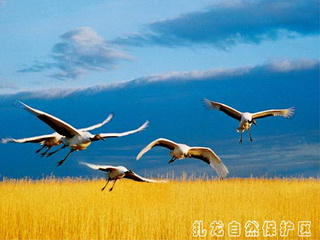search for a Trip
The Zhalong Nature Reserve is the largest wetland ecological reserve in China set aside for the protection of the crane and other birds. On the lower reaches of the Wuyur River in the Songhua-Nenjiang Rever Plain in western Heilongjiang Province, it is 26.7 kilometers southeast of Qiqihar and covers an area of 2,100 square kilometers.
It stands 142.5 meters above sea level and has a temperate semi- wet continental climate.
The reserve is rich in bird resources and is home to 296 types of birds. Most are waterfowls. The varieties and numbers of cranes are rare in the world China is home to nine of the 15 varieties extant in the world. The reserve boasts six of these nine.


The red-crested crane, white-naped cane, white-plumage crane and common crane are nest in the reserve and the white crane and white-headed ibis winter in the reserve such rare birds as the while stork, black stork,swan, while ibis and great egret, as well as geese and ducks, visit the reserve. It is really a paradise of birds and a home of cranes.
By the western edge of the reserve, a tourism zone has been designated to serve bird watchers, the first of its kind in the country. The bird watching gone is eight kilometers from north to south and nine kilometers from east to west, covering an area of 1,550 hectares and accounting for 0 7 percent of the total area of the reserve.
The scenic spots include the vushrlgang Pavilion, where visitors can view a video about the Zhalong Nature Reserve and cranes, call climb to the top of the pavilion to watch the wetland cranes and waterfowl and can visit exhibitions and domestication farms; South Zhalong Lake, North Zhalong Take, Sigouzi (a river channel) and the Zhalong Fishing Pool, where they can observe geese, ducks, pheasants and other birds; Jiujefang and Dachangzi, where visitors can see ibis, egret, crane, stork and other wading birds and birds of prey, Tumukesigang, where they can observe birds of the field and residential areas, and the Zhalong sapling farm and grasslands, where they can see forest birds and such grassland wild fowl as the great bustards.
This reserve has been developed into a national crane research center, a publicity and education center of bird protection and a bird watchers paradise.
Related Tours:
China Attractions Guide
- Anhui Attractions
- Beijing Attractions
- Chongqing Attractions
- Fujian Attractions
- Gansu Attractions
- Guangdong Attractions
- Guangxi Attractions
- Guizhou Attractions
- Hainan Attractions
- Henan Attractions
- Hongkong Attractions
- Hubei Attractions
- Hunan Attractions
- Inner Mongolia Attractions
- Jiangsu Attractions
- Jiangxi Attractions
- Manchuria Attractions
- Ningxia Attractions
- Qinghai Attractions
- Shaanxi Attractions


